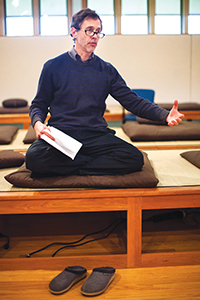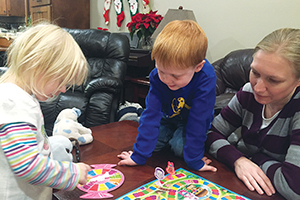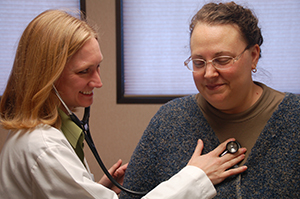By JUDITH VANDEWATER
SCOTTSDALE, Ariz. — Much of what physicians do is based on their ability to form meaningful and trusting relationships with patients. The capacity to make those connections, to listen deeply and respond fully to the mental and emotional suffering of others day in and day out is in no small part dependent on the physician's own sense of self-efficacy, self-knowledge and spiritual well-being, according to speakers at CHA's Physician Leader Forum in mid-November.
To take care of others, doctors need to take care of themselves first. But high rates of moral distress, burnout and even suicide among doctors — researchers say physicians are twice as likely to kill themselves as nonphysicians — signal that disillusionment, emotional exhaustion and suffering in isolation are widespread.
The CHA meeting held Nov. 15-17 brought about 65 physician leaders, mission leaders and system formation directors to Scottsdale to explore approaches that could increase physician resilience and job satisfaction.
Forging connections
Both keynote speakers, Dr. Christina Puchalski and Dr. Ronald Epstein, have published research on the restorative value of mindfulness training and regular spiritual practice by health care professionals. At the forum, both expressed the belief that professional development programs offered by hospitals and health systems should reconnect practitioners with their calling and purpose as healers, and with each other by building a sense of community.
Puchalski, an internist, palliative care specialist and secular Carmelite, directs the George Washington Institute for Spirituality & Health at the George Washington University School of Medicine and Health Sciences in Washington, D.C. Epstein is a professor of family medicine, psychiatry and oncology and director of the Center for Communication and Disparities Research at the University of Rochester Medical Center in Rochester, N.Y. Although physician burnout has been recognized in the scientific literature for decades, both Puchalski and Epstein said the pressures on physicians today have only worsened.

Brett Carlsen ©
In this 2011 photo, Dr. Ronald Epstein leads a session at a mindful communication training conference for physicians at the Chapin Mill Retreat Center in Batavia, N.Y.
"Our field values competition over nurturing," Puchalski said. Physicians who do not find healthy ways to meet their own needs and stay attuned to the essential joy and purpose of the work are at high risk of disconnecting emotionally from themselves and from their patients, she said.
Reflection rounds
Together with her George Washington colleague, Dr. Benjamin Blatt, and with input from Sr. Rose Mary Dougherty, SSND, a spiritual teacher of meditation and author, Puchalski developed a standardized format for "reflection rounds" now in use at 10 medical schools. The design gives medical students the regular opportunity to think deeply about a significant encounter with a patient. Together with about eight to 12 peers, and under the guidance of a pastoral care provider, the student explores how the interaction brought up personal feelings of unresolved loss or suffering, challenged preconceived notions or deepened their sense of spirituality and purpose.
In her own medical practice, Puchalski said she pauses to center herself before entering each patient's room to be fully present for each encounter. "Being present flows from deep intent" to connect, she said.
Puchalski believes that a physician's greatest joy is in the patient relationship.
Moral distress
Epstein said that the everyday mechanics of health care delivery can work against the physician-patient relationship. He referred to the "widgetization" of health care and gave as an example a drop-down menu in a computerized patient exam that prompts him to ask four questions of diabetic patients. "None of the questions include 'How are you doing?'" he said. "Sometimes I notice myself asking those four questions and not really paying attention to the how-are-you-doing questions."
He said a similar regression to the expedient can occur when an insurer changes its drug formulary. Rather than "kick and scream" to have a patient approved to get continued coverage for a drug that has worked effectively for the individual for years, Epstein said he sometimes switches the patient to a drug on the insurer's formulary. "Ninety percent of the time it doesn't make a difference, but 10 percent of the time it does," he said.
Epstein said the schism between doing what is best for the patient and what is expedient can contribute to a cumulative sense of moral distress that is emotionally exhausting to the physician.
Take control
Epstein encouraged forum participants to view their actions through the lenses of intention, attention and habit. He defined intention as how one translates a life calling into practice, attention as consciously focusing on what really matters in order to act with awareness, and habit as what a person does when no one is looking.
It is possible to self-monitor on a continuing basis, he said, and self-awareness can lead to clear thoughts and emotional stability. He introduced "mindfulness practice," a type of meditation to enhance moment-to-moment awareness and called it a useful tool for physicians. By observing what is going on inside and outside of oneself, one can identify thoughts and feelings as they arise. Mindfulness practice can give a diagnostician insight into personal observational biases, sharpen observational skills and help a physician develop the discipline to deeply listen to a patient without interrupting. "You can practice presence," he said.
Epstein told the audience that like mindfulness, resilience can be cultivated. "Everyone wants a doctor who is resilient," he said.
Resilience requires more than adapting to adversity; it requires the capacity to grow from a challenging or painful experience. "Resilience does not feel like smooth sailing," he said, and that is particularly true owing to health reform. "Now in health care we need to tolerate the ability to always feel a bit off-balance," he said.
The practice of self-compassion and understanding one's self as an emotional being builds resilience, as does compassionate engagement with another, he said.
Epstein helped direct a study at The University of Rochester School of Medicine and Dentistry that employed a secular form of mindfulness training. Participants wrote about clinical experiences and engaged in "appreciative dialogues," to reinforce positive experiences and success in working through difficult clinical situations. Sharing and listening to others' stories were equally important, the researchers said. The combined practices increased physicians' emotional stability and fostered the type of connections with peers and family members that inoculate individuals from stress.
Health systems' role
In response to a question from a CHA forum participant, Epstein said that research has shown that high levels of responsibility combined with low control over decision-making are a root cause of physician burnout. He gave as an example of low control a health system that took over a group physician practice and redecorated every room with the exact same art prints. "They mandated depersonalization" in what is essentially a human enterprise, Epstein said. He added that studies have shown that when clinicians have more control over the layout of their offices and the art on the walls, they report a decrease in symptoms of exhaustion and burnout.
Epstein challenged hospitals and health systems to address physician burnout in a systematic way. When physician disaffection begins to impact patient care, burnout graduates from an individual problem to a health system problem, Epstein said. "Burned-out physicians cost the health care system a lot of money.
"We are getting to a point that health care institutions really need to step to the plate; these things are in everyone's self-interest."
| Avera Health's LIGHT program encourages physicians to take care of themselves By JUDITH VANDEWATER SCOTTSDALE, Ariz. — Fresh out of residency and in her first family medicine practice, Dr. Jill Kruse was overextended. She had a toddler at home and a baby on the way. In addition to treating patients, she was medical director, trauma director, palliative care director, nursing home medical director and emergency medical services director for St. Michael's Hospital Avera, a critical access hospital in Tyndall, S.D. She was on call every fourth night. While she looked to the outside world like a fireball, she was sleep-deprived, over- extended and burnt out.  Dr. Jill Kruse plays a game with her children, 3-year-old Allison Anderson and 5-year-old Tyler Anderson. When she got called to the hospital in the middle of the night for an emergency, she stewed with resentment on the drive, consciously pulling herself together before she walked into the emergency room. No one, save her husband, knew the extent of her discontent. She recalled him saying, "You need to do something different. Either find another job, or find another husband." "I was falling apart from the inside out," she said. "I had so many titles and hats on that I couldn't take care of myself, let alone my children, let alone my patients. I was physically exhausted. I was mentally exhausted. I was emotionally exhausted." Something had to give. Kruse told the audience during a presentation on physician wellness at the CHA Physician Leader Forum here that she was determined to use her six-week maternity leave, which began in September 2012, to create a lifeline for herself and other overwhelmed, depressed or otherwise at-risk physicians. That pursuit led to the LIGHT Program, a wellness program for Avera Health's doctors and advanced practice clinicians. Kruse is LIGHT's medical director. Physician burnout is widespread, but most doctors suffer in isolation rather than risk appearing weak, Kruse said. According to a study published in September 2009 in The Journal of the American Medical Association, up to 60 percent of primary care physicians reported symptoms of burnout, including emotional exhaustion, a low sense of accomplishment and a feeling they were treating patients as objects. Last month, JAMA published a report based on 50 years of peer-reviewed studies that concluded nearly one in three medical students and newly minted doctors experience depression. Another paper on physician depression, this one published in Medscape in July, said reliable estimates are that about 400 physicians commit suicide each year.  Dr. Jill Kruse examines Debra Johnston at Avera Medical Group Brookings clinic in Brookings, S.D. Back from her maternity leave, Kruse met with Dr. Tad Jacobs, Avera's chief medical officer, to share her concerns about herself and other doctors experiencing burnout. In 2013, Jacobs recruited Kruse and several other physicians to meet monthly to discuss what Avera could do to support physician well-being. Kruse reached out to institutions with innovative physician wellness programs, including The Vanderbilt Center for Professional Health, Brigham and Women's Hospital and The Coalition for Physician Well-Being, to learn about best practices. That same year, Kruse and her family moved to Brookings, S.D., where she joined the Avera Medical Group Brookings. The "physician burnout committee" spent much of 2014 building its ranks — it fluctuates from about 15 to 20 members. Its members talked to hospital and medical service line administrators to start bringing burnout out of the shadows. In September 2014, the group got its first annual operating budget allocation of $150,000 from Avera, and it adopted a new name: the LIGHT Program. The name is an acronym for live, improve, grow, heal and treat. It contracted Dr. Dike Drummond, a physician coach, to give on-site presentations on burnout prevention throughout Avera's five-state service area. In 12 days, Drummond talked to more than 350 providers and 35 spouses of physicians. He now coaches nine Avera doctors, including Kruse, on an ongoing basis. Kruse said LIGHT pays for half of the coaching fees and the individual physicians pick up the rest. Stephen Tappe, vice president of mission for Sioux Falls, S.D.,-based Avera and Kruse's co-presenter at the CHA physician forum, said Drummond also met separately with administrators at all of the facilities he visited. "That was highly instructive," he said. "When you see a physician, you are not really seeing the real person. You are seeing the armor that the physician puts on, that they've been trained to put on. They always need to be right — that is how they are trained to make a diagnosis.'" Tappe said that insight helps administrators understand the internal struggles of physicians. Kruse said doctors are not inclined to ask for personal help, but the outreach by the LIGHT program is breaking through that resistance. More Avera doctors than ever are reaching out for help from the system's employee assistance program. Clinicians use wellness resources on the LIGHT webpage on Avera's intranet, too; it's had more than 400 hits. Mary Wolf directs LIGHT and Avera's EAP. Wolf is training physicians as peer coaches because, as Kruse explained, for physicians, "It's much easier to talk to someone who has been in the trenches with you" than to a social worker. LIGHT plans to work with The Coalition for Physician Well-Being to integrate a physician well-being self-assessment tool into the annual physician physical. The data it generates will allow Avera to compare its physician burnout rates to the national norm and track the effectiveness of the LIGHT program, Kruse said. "This program is priceless if we can save a life," Kruse said of LIGHT. |
Copyright © 2016 by the Catholic Health Association
of the United States
For reprint permission, contact Betty Crosby or call (314) 253-3477.